Is orange your favorite color? Well today, you are in luck! We’re going to explore the types of orange-breasted birds which you can find out there so that you can learn a little about these colorful characters and perhaps add a new bird or two to your list. While we’d like to chronicle every orange-breasted bird out there, we simply don’t have the space (and let’s face it, eventually you would get a little sleepy). To this effect, we’ve selected 15 strikingly beautiful orange-breasted birds which we will list for your pleasure along with an interesting fact or two that you can file away.
Types of Orange Breasted Birds
Without further ado, let’s take a look at some beautiful orange-breasted birds!
Allen’s Hummingbird – Selasphorus sasin
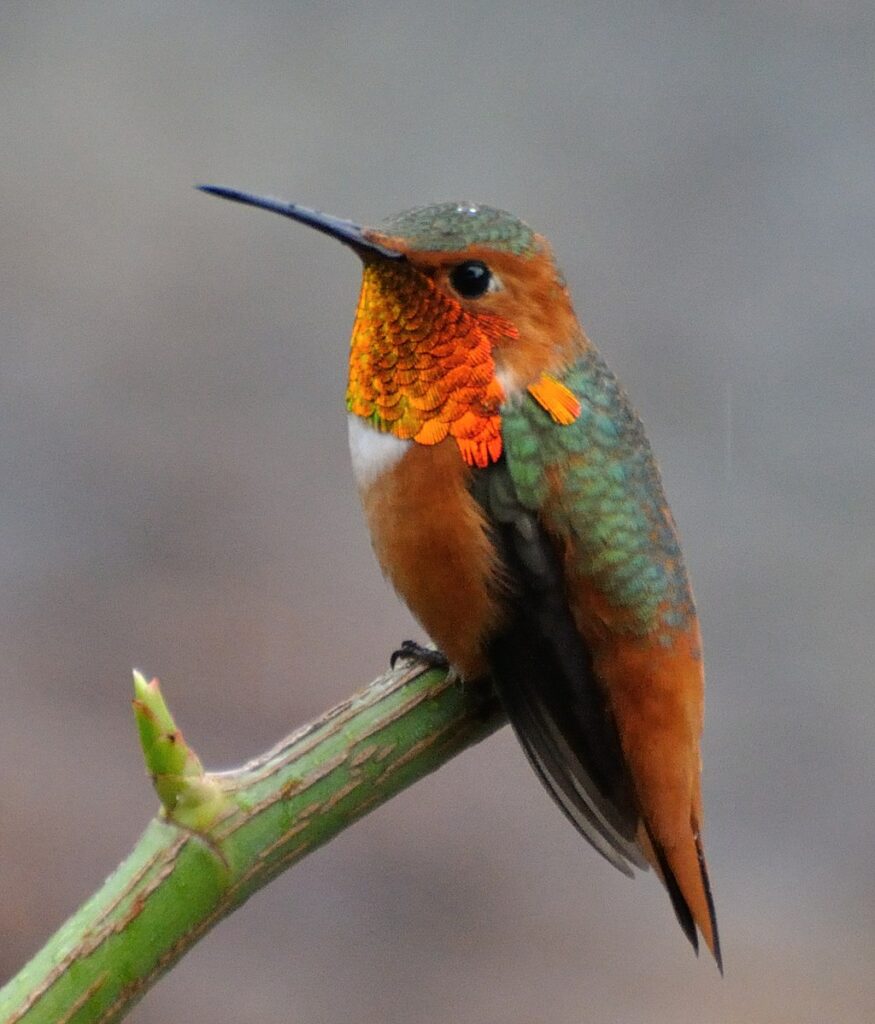
Coloration and Markings: Male Allen’s Hummingbirds have backs the color of patinaed bronze which becomes orange as the coloration approaches the rump. They have small, gray wings and short, orange tails. The rump is white at the underside and the belly and breast of this bird are orange, excepting a v-shape of white at the peak of the breast. This Hummingbird has a vibrant orange bib and facially the male Allen’s is also orange with a thick, gray crown. This bird has a long, straight black bill.
Size: These little birds measure in at approximately 3.5 inches from tip to tail and have wingspans averaging 4.3 inches wide.
Diet: Tree sap, small insects, and nectar are the preferred fare of the Allen’s Hummingbird.
More about the Allen’s Hummingbird
Allen’s Hummingbirds are beautiful little creatures that may be found on the West Coast and you might also spot them occasionally wintering in Mexico. These little guys have a lifespan of 3 to 5 years, though the oldest reported was released at an age of 5 years and 11 months when it was released. An interesting fact about the Allen’s Hummingbird is that it is a very high-diving bird. Adult males of this species begin by flying in a pendulum arc, increasing their elevation to as high as 65 feet in some cases, before popping briefly higher up and zooming down at high velocity on a female or on a rival male!
Allen’s Hummingbird is tiny, but it sure has attitude (and altitude!).
American Robin – Turdus migratorius
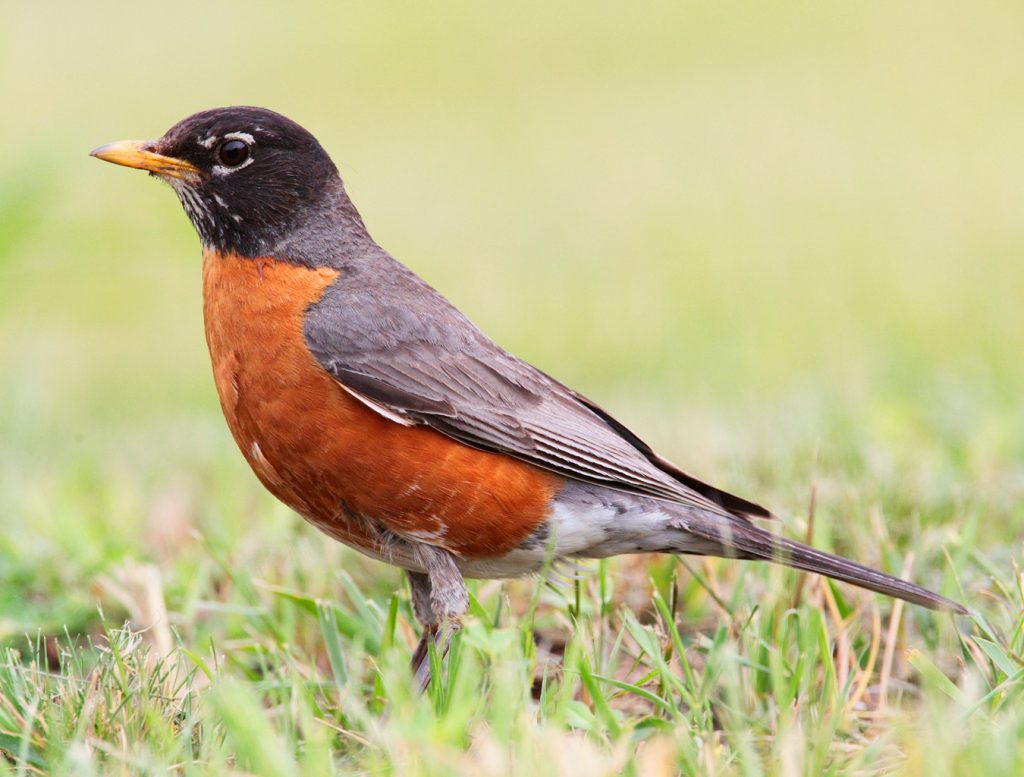
Coloration and Markings: American Robins have gray backs with medium-length gray wings and long, gray tails which are white on the undersides. The rump of this bird is white but the belly and breast of the Robin are a warm and lovely orange. Facially, this bird has a black head with a ‘segmented’ white eyering and a medium-length, slightly curved yellow bill.
Size: These birds measure in at 7.9 – 11 inches in length and have wingspans of 12.2 to 15.8 inches wide.
Diet: Robins love to dine on caterpillars, grasshoppers, earthworms, and whatever fruits and berries they can find.
More about the American Robin
American Robins may be found just about anywhere in North America, even in Alaska, but you can also find Robins in Europe as well. In fact, the Robin is the national bird of Great Britain! As it turns out, these hardy Thrushes thrive in just about any clime, although they have a fairly short lifespan – only 2 years. These little guys make the most of those two years, however, and have even been known to get drunk! You heard us right. Robins sometimes gorge on fermented berries in large amounts, and while we can’t confirm 100% that they are intoxicated, they begin demonstrating some highly-suspicious behavior, such as falling over when they walk.
American Woodcock – Scolopax minor

Coloration and Markings: American Woodcocks have backs which are colored a mix of tan, black, gray, and light brown, which extends onto their medium-length, rounded wings and onto their short, stubby tails. This coloration extends into the breast in the form of ‘backpack straps’, but the belly and breast of this bird are a lovely light buff-orange color. Facially, this bird bears the same camoflauge mix of colors as seen on the back and this bird has an extremely long black bill which is light orange in color and flecked with black spots.
Size: These birds measure in at 9.8 – 12.2 inches in length and have wingspans of 16. To 18.9 inches wide.
Diet: While earthworms account for 50 – 90% of this birds diet, they also dine on beetles, centipedes, flies, and other small invertebrates.
More about the American Woodcock
Found all over Northeastern America, the American Woodcock has a relatively robust lifespan when compared to the Robin, living for an average of 8 years. These birds are ground foragers and the position of their eyes allow they to look for predators both around them or above them at the same time that they are rooting around for delicious snacks. This bird also has a number of amusing aliases, known in some places as a ‘the Bogsucker’, ‘The Timberdoodle’, ‘The Hokumpoke’, and our favorite… ‘The Labrador Twister’.
These birds do have an Achille’s heel, as it were, and this is in how they respond to threats. If you startle a Woodcock their first reaction is to freeze in place. This is an unfortunate reaction, as they have been known to do this in the road, much to their own detriment. On a more pleasant note, the certainl have an interesting way of foraging. The American Woodcocks rifles his bill in the dirt, while rocking back and forth and stomping one foot into the ground. It is believed that they are able to either stir activity in the worms below or perhaps even detect them by means of this technique.
Baltimore Oriole – Icterus galbula
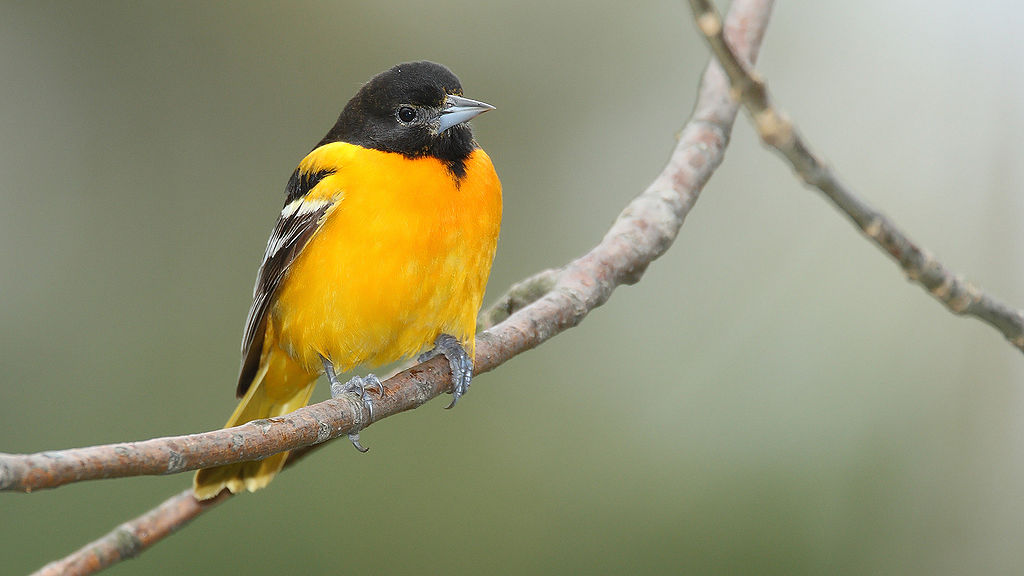
Coloration and Markings: Male Baltimore Orioles have black backs which are orange at the lower half, with medium-length black wings accentuated with white highlights and one white wingbar on each wing. They have long, pointed black tails which are edged with orange and orange underneath. The belly and breast of this bird are the same vibrant orange color and facially, the Baltimore Oriole is black with a medium-length, lightly curved silver bill. Females and juveniles will be more gray than black, with yellowish-orange plumage and 2 distinct white wingbars visible.
Size: These birds measure in at 6.7 – 7.5 inches in length and have wingspans of 9.1 to 11.8 inches wide.
Diet: Baltimore Orioles have a varied diet, enjoying wasps, mealworms, fruits, and flowers (especially the buds).
More about the Baltimore Oriole
Baltimore Orioles may be found in the Eastern portions of the United States and in Canada as well, though they like to migrate in the winter for warmer climes, specifically South and Central America. They live on average about 11 years, though they can live up to 14 years in captivity but one of the neatest facts about the Baltimore Oriole is that it has an amazing nest.
For a period of about 5 to 8 days the female begins gathering and weaving together bits of hair, string, and various grasses to create a thing of wonder and beauty. A hanging nest, suspended sometimes as high as 30 feet, and these nests are so well-made that after the winter has passed these birds will often come back and use them again! It’s definitely a sight to see.
Barn Swallow – Hirundo rustica
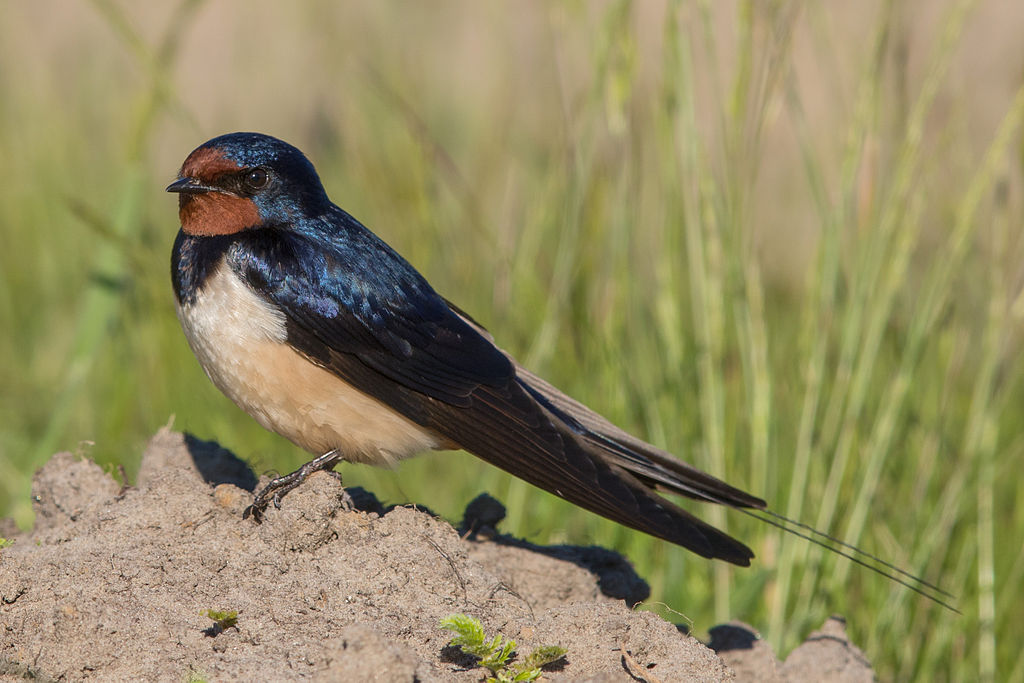
Coloration and Markings: Barn Swallows have deep blue backs and long, pointed blue wings to go with their long, blue tails. These tails are forked and a dotting of white is visible just below the rump when this bird is in flight. The belly and breast of this bird are a deep reddish-orange and you’ll notice blue ‘backpack strap’ marks entering the upper breast in a v-shape, making the wings look rather like a superhero’s cape. Facially, the Barn Swallow is an even deeper orange red at the chin and just under the cheeks, and this color carries up to triangulate and end just above the bill. The remainder of the head is the same steely blue of the wings, with the exception of a striking diamond-shaped mask. This bird has short, sharp black bill.
Size: These birds measure in at 5.9 – 7.5 inches in length and have wingspans of 11.4 to 1.6 inches wide.
Diet: Barn Swallows are insectivorous, dining on moths, grasshoppers, beetles, flies, and any other small insects which they can catch.
More about the Barn Swallow
Another bird that winters in Central and South America is the Barn Swallow, though in the warmer months you’ll find them throughout most of the United States and even a good chunk of Canada. These little guys have a wide range of habitats but their lifespan is only about 4 years. Still, they have quite a bit of fame about them and are even considered legendary.
A Native American myth states that the Barn Swallow got his forked tail after he boldly flew into the sun to steal fire from the gods and to give it to men. One of the angry gods threw a firebrand at the Swallow and it burned the center of his tail, remaining missing to this day.
Black-headed Grosbeak – Pheucticus melanocephalus

Coloration and Markings: Male Black-headed Grosbeaks have black backs, with medium-length black and white wings which sport a white wingbar on each wing. They have long, rounded tails which are black and white on top and white underneath, save for a black bar close to the rump. The rump itself is white with a spot of orange and the belly and breast of this bird are a lovely orange that carries up to the throat and across to the back of the head, while the head itself is black. These birds have large, powerful, and conical gray bills. Female and Juvenile Grosbeaks will be brown instead of black and have a lighter orange coloration with some streaking at the sides of the breast.
Size: These Grosbeaks measure in at 7.1 – 7.5 inches from tip to tail and have wingspans of approximately 1.6 inches wide.
Diet: These birds dine on grains, fruits, and even the occasional snail, whose shell is no match for their powerful bills.
More about the Black-headed Grosbeak
While the Black-headed Grosbeak Winters in Mexico, when it gets warmer you can find these beautiful birds throughout the Eastern United States. They have a modest lifespan of 5 to 6 years and as it turns out, the males are exemplary fathers! They spend as much time as the females incubating the eggs and once the chicks are hatched, the happy couple spend an equal amount of time feeding and taking care of them.
These birds also have a superpower that most other birds don’t have. While they are wintering in Mexico, Monarch Butterflies arrive and the Black-headed Grosbeak begins to feast. This doesn’t sound so impressive unless you know that Monarch Butterflies are highly toxic. The specialized digestive systems of the Grosbeaks allow them to safely consume the Monarchs, which they do in intervals of 8 days. This gives the toxins enough time to be safely ingested and cleared out before the next feeding!
Bullock’s Oriole – Icterus bullockii

Coloration and Markings: Male Bullock’s Orioles have black backs and medium-length black wings which display a white wingbar on each. They have medium-length black tails which are a vibrant orange underneath and the belly and breast of this bird are orange as well. Facially, this bird has a black chin and throat, with an even more vibrant orange color taking up most of the head, with the exception of a thin eyeline that goes to the back of the head and a black crow. These birds have long, sharp-looking gray bills. Females and juveniles are colored a little different, being more of a yellowish orange on their tails and their heads and they will have gray backs and wings with the wingbar looking more clean and prominent.
Size: These birds measure in at 6.7 – 7.5 inches in length and have wingspans of approximately 12.2 inches wide.
Diet: Bullock’s Orioles love to eat fruits, nectar, and small insects.
More about the Bullock’s Oriole
Ranging across the Western half of the United States we have the Bullock’s Oriole, a colorful character indeed. These birds live about 7 years in the wild and their territory just happen to overlap that of their cousins, the Baltimore Orioles, in the area of the Great Plains. This results in hybridization in the areas which probably makes for some interesting identification arguments for Great Plains birders.
One interesting fact about Bullock’s Orioles is that they are quite observant. Like the Cuckoo, the Brown-headed Cowbird has a sneaky habit of leaving eggs in an unsuspecting bird’s nest so that their chick will hatch and be reared to the detriment of the unwitting foster-parent’s chicks. Most birds fall for this trick, but not the Bullocks, who are one of the few species around that see right through it. They will peck and puncture the offending egg and flip it out of the nest. This sometimes damages their own eggs, in the process, but it saves more young then it endangers.
Eastern Bluebird – Sialia sialis
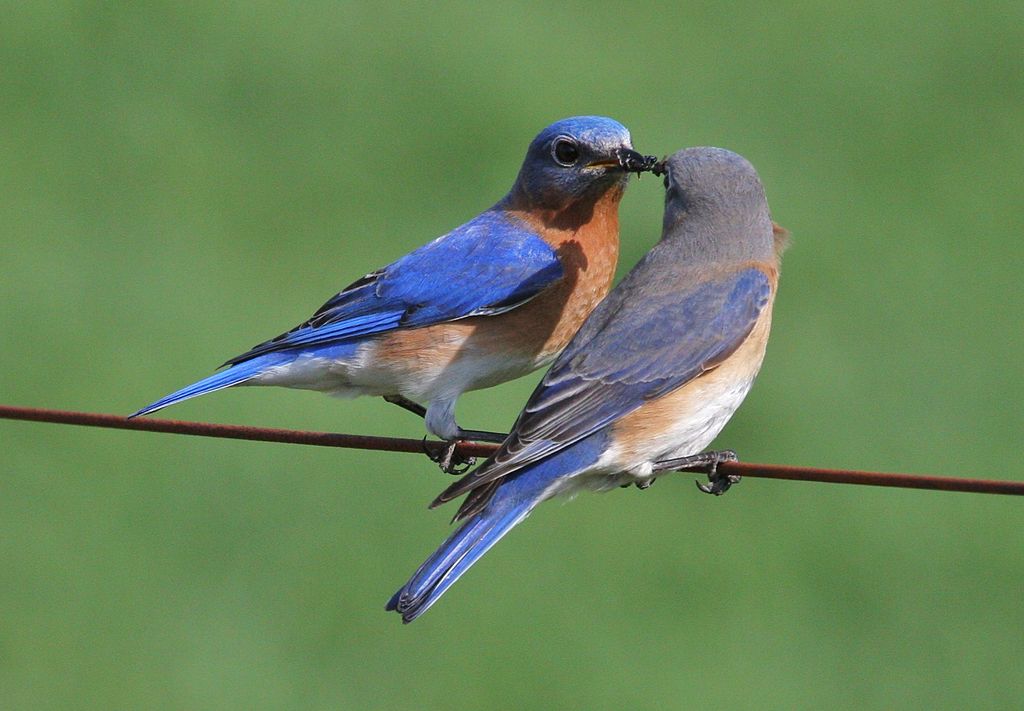
Coloration and Markings: Male Eastern Bluebirds have lovely blue backs with long, blue wings and short, blue tails. The rump and belly of this bird are a snowy white, with an orange flanking at the belly which increases in density to fill the breast. This orange carries up to the throat, extending across to the back of the head, but goes no further up except in a thin line at the bird’s chin. The remaining portions of the face are blue and this bird has a medium-length, slightly curved silver bill. Females will be more grayish-blue and have more subdued orange at their breast.
Size: These birds measure in at 6.3 – 8.3 inches in length and have wingspans of 9.8 – 12.6 inches in width.
Diet: Eastern Bluebirds primarily feast on caterpillars, crickets, and beetles but as the colder months approach they will also forage for fruits and berries.
More about the Eastern Bluebird
The Eastern Bluebird is a year-round resident of the Eastern United States and it’s a little bird with a big lifespan, generally 6 to as high as 10 years. They don’t need glasses, either, as these sharp eyed birds can see tiny bugs from as far as 60 feet away!
It also turns out that Eastern Bluebirds are a little picky about their homes. If you are trying to attract one to a nesting box and you aren’t having any luck, then here is a pro tip. An Eastern Bluebird is only going to move in if the entry hole is 1 ¾ inch in diameter and the box itself is a cozy 4-inch square at the base. You might get lucky with your current box but if you really want to hedge your bets, obtain or make a box with these measurements and we think that you and those Bluebirds will be quite happy with the results!
Orange-breasted Sunbird – Anthobaphes violacea

Coloration and Markings: The stunning Orange-breasted Sunbird is turquoise at the top of the back and shoulders, while the remained of the back is a light orange and gray mix. They have short wings which are mostly gray with oranges mixed in and they have very long gray tails The rump, belly, and breast of this bird are a deep yellowish-orange and a purple breastband is seen at the peak of the breast. Facially, this bird has an iridescent dark green or turquoise head and these birds have long, noticeably curved black bills.
Size: These birds measure in at 4.9 – 6.4 inches in length and have wingspans of approximately 6.7 inches in width.
Diet: These Sunbirds like to feed on small insects and spiders but their primary diet is nectar.
More about the Orange-breasted Sunbird
The Orange-breasted Sunbird is a beautiful entry from South Africa and it’s got an impressive lifespan, living between 16 and 22 years! They have interesting nesting habits, much like the Baltimore Orioles. The female creates a ball-shaped nest, which she fashions by gathering together leaves, pieces or roots, twigs, and grass and seals together in a ball-shape with cobwebs. Once the nest is ready then it is placed in the concealment of a bush where the mother will lay only 1 to 2 eggs, which are white in color with little flecks of brown. Both the male and female Sunbird take care of the young but the male is a little on the lazy side, leaving his mate to do about 2/3 of the work! They take care of their young for a period of about 3 weeks and then it’s time for the kids to fend for themselves and the cycle begins again.
Orange-breasted waxbill – Amandava subflava

Coloration and Markings: Orange-breasted Waxbills have olive and gray backs, with medium-length wings and tails of the same color. The belly and breast of this bird, however, are a rich orange with a flanking of olive coloration peppering the sides, just underneath the wing and framing the breast. Facially, this bird has an orange chin and eyebrows while the cheeks and crown will be olive green or green and gray. These birds have pointy, conical orange bills.
Size: These tiny Waxbills measure in at 3.5 – 4 inches in length and have wingspans of 6.5 to 7.5 inches wide.
Diet: Grass seeds make up much of the Waxbills diet, however, it also dines on termites, mealworms, maggots, and small crickets.
More about the Orange-breasted Waxbill
A second entry from Africa in our compilation of orange-breasted birds is he Orange-breasted Waxbill. This stunning avian is found in the savannahs and the grasslands of the Sahara and enjoys a modest lifespan of approximately 7-8 years. These birds are the tiniest members of the Estrildid Finch family and because of their lovely plumage and good temperament they are considered highly desirable in the local pet trade. This leads to exportation, of course, and because of their native clime UK and other owners are advised to keep a heat source near their cages for the winter months.
These birds tend to travel in pairs, rather than groups, as breeding season brings out the worst in the males and fights will ensue during this time. Once mated, the Waxbill also has another problem to worry about, as they are often targeted by the Red-collared Widowbird, who likes to leave her eggs in the unsuspected Waxbills nest!
Red-breasted Nuthatch – Sitta canadensis
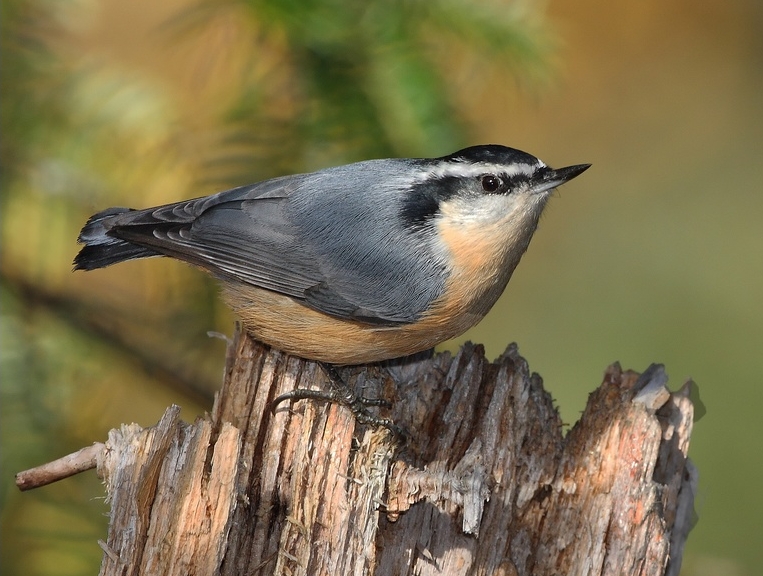
Coloration and Markings: Red-Breasted Nuthatches have grayish-blue backs, with long grayish-blue wings which are gray at the tips and short grayish-blue tails. Their rumps are orange with a touch of blue flanking at the belly. The belly and breast are a smooth cinnamon-orange that carries up and triangulates just under the bill, where a light mix of white suffuses the color. Facially, this bird has a white face with a black mask that terminates at the back of the head and a black cap. These birds have long, straight black bills which show a small amount of white sometimes on the lower bill.
Size: These birds measure in at approximately 4.3 inches from tip to tail and have wingspans of 7.1 to 7.9 inches wide.
Diet: Beetles, wasps, caterpillars, and even insect eggs play a large part in the Nuthatch’s diet, though it is also quite fond of conifer seeds.
More about the Red-breasted Nuthatch
Found in most areas of the United States, as well as Canada, The Red-breasted Nuthatch is an adorable little bird with a lifespan of around 6 years. They are interesting little characters, too, and you may not know that they hoard food to save it for later. These clever little birds have a habit of wedging bits of nuts into the bark of trees, which they then peck and push in place in order to store it for later.
They also have a little trick which is presumably for gumming up the wings of predators when it comes to nesting. The male and female work together, gathering globules of resin from nearby trees which the male applys around the outside entrance while the female does the same to the inside. So, doesn’t this stick up the Nuthatches too?
Not at all. The Nuthatches know it is there and so when they want to enter, they simply swoop in at high speed, avoiding the sticky mess altogether.
Red Knot – Calidris canutus

Coloration and Markings: Red Knots have backs which are a mix of gold, orange, buff-tan, and black. They have medium-length wings of the same color and short, black tails which bear the same color mix as the back underneath. The belly and breast of the Red Knot are a buff-orange color and facially, most of the bird’s head is buff orange with the exception of an eyeline and cap which are the same complex mix of colors seen on the bird’s back. This bird has a long, straight black bill.
Size: These shorebirds measure in at 9.1 – 10.6 inches in length and have wingspans of 22.4 to 23.6 inches wide.
Diet: These birds love to eat mollusks and they don’t even de-shell them, preferring to gulp them down whole. They are also fond of Horseshoe Crab eggs.
More about the Red Knot
Red Knots are North American Coastal Sandpipers which are also sometimes found in Mexico, who migrate along the coast as needed and tend to winter in Canada and in the state of Alaska. These birds are well-suited for the rigors of Tundra temperatures and have an average lifespan of approximately 27.3 years. Also known as the ‘Robin Snipe’, Red Knots are famous for flying long distances when it comes to foraging for food, in some cases are far as 9300 miles. Don’t believe us? Well, one Red Knot that was banded in 1987 was seen 13 years later in Delaware and in that time had flown an estimated distance of 242,350 miles. To put that into perspective, this is a distance that is farther away than the Earth is from the Moon!
Rufous Hummingbird – Selasphorus rufus
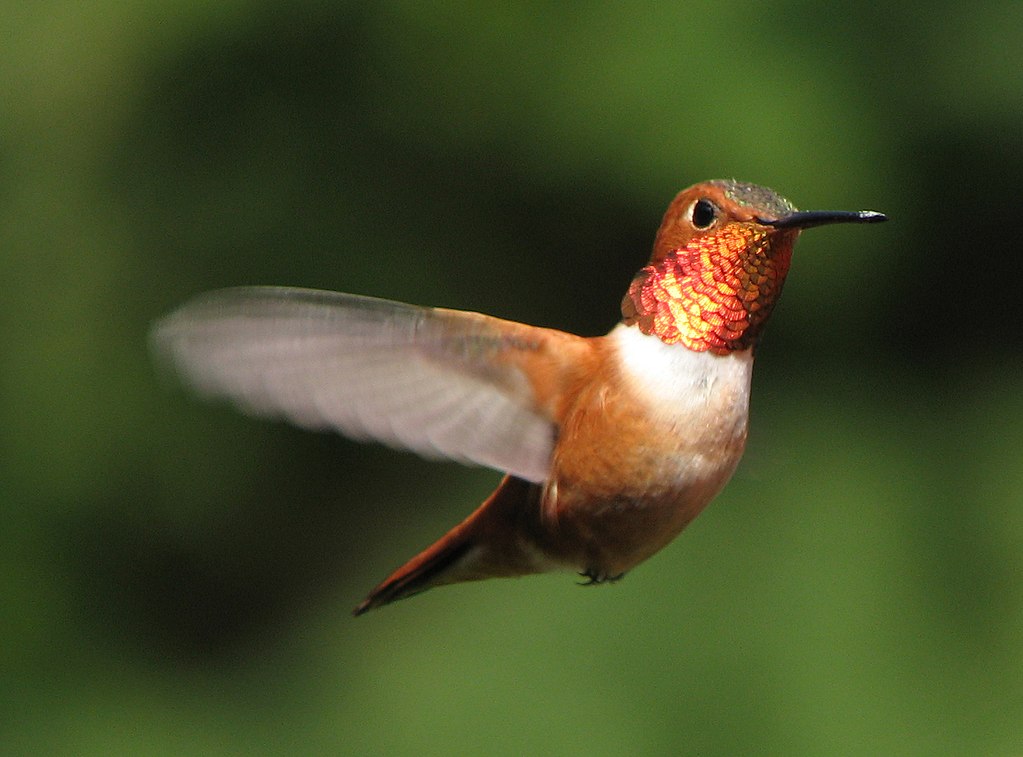
Coloration and Markings: Male Rufous Hummingbirds have tangerine-orange backs, with short black wings and tapering, medium-length black and orange tails. They have white rumps with orange bellies and the coloration slowly moves into a flanking to part for a white v at the apex of the breast. The effect is much like the bird is wearing a sharp orange vest. Facially, this bird has a reddish-orange chin, while the face is a lighter orange and it has a yellowish-green cap. These birds have long, straight black bills.
Size: These birds measure in at 2.8 – 3.5 inches in length and have wingspans of approximately 4.3 inches in width.
Diet: Rufous Hummingbirds eat small insects and nectar, though when they cannot find enough of either they have been known to take sap from holes that Sapsuckers have previously drilled into trees.
More about the Rufous Hummingbird
Another long-distance traveler that makes its home in western North America, the Rufous Hummingbird will travel a distance of 4000 miles from breeding locations in Canada and Alaska to get to Mexico. This is nothing short of amazing for a 3-inch bird with a lifespan of only 8 years. They can also breed with many other different types of Hummingbirds, just to make bird identification just a little more challenging.
Another impressive trait of Rufous Hummingbirds is their memories. These birds can go away on migration and when they come back, they have a perfect memory of their favorite haunts and feeding grounds. We suppose that it just goes to prove the old adage that good things really do come in small packages!
Western Bluebird – Sialia mexicana

Coloration and Markings: Male Western Bluebirds have blue backs with some orange at the shoulders, as well long, blue wings and short blue tails. The undersides of the tail are white, as is the rump and belly of this bird, though an apricot-orange flanking begins at the belly and increases in density until it takes up the entirety of the upper breast. Facially, this bird is a deep blue with a small, straight black bill.
Size: These birds measure in at 6.3 – 7.5 inches from tip to tail and have wingspans of 11.4 to 13.4 inches wide.
Diet: Western Bluebirds subsist on a diet of insects during the warmer months but when it gets colder they happily add fruits and seeds into the mix.
More about the Western Bluebird
As the name suggests, you can find these little guys all over the Western United States and they often reuse their nests, so be sure to put a box out for them if you’d love a new blue tenant. Western Bluebirds, on average, live between 6 and 10 years and you might not know it, but they are a deeper shade of blue than their Mountain Bluebird relatives. The ladybirds are also a little promiscuous, as it turns out. Studies have concluded that 45% of the young being raised by the Bluebird male were not his own! It only seems fair, however, when you consider Avian males on the whole so score one for the female Western Bluebird! Another curious fact about Western Bluebirds is that they like to occupy vacated Woodpecker holes. As it turns out, the Bluebird’s bill is simply not cut out for excavation, so the Bluebirds simply search around and if the resident Woodpecker has moved off for greener pastures they are more than happy to move into it’s old home.
Varied Thrush – Ixoreus naevius

Coloration and Markings: Male Varied Thrushes have bluish-gray backs, with medium-length orange and black wings which have two orange wingbars apiece. They have short, black tails with a grayish-white coloration on the undersides and at the rump and the belly of this bird is white with a heavy flanking of orange. This flanking increases in density to fill the breast and travels upwards, deepening in color and only interrupted briefly by a thick, black line that v’s across the upper breast. The face of this bird is orange with a thick, black mask and a black crown and this bird has a long, straight bill which is black but with a touch of orange at the lower bill.
Size: These birds measure in at 7.5 – 10.2 inches in length and have wingspans of 13.4 to 15 inches wide.
Diet: The Varied Thrush enjoys a diet of insects, nuts, and whatever berries that it can forage.
More about the Varied Thrush
The Varied Thrush likes to spend its winters in the Western United States, ranging as far as Alaska and even Canada in some cases. With a relatively short lifespan of around 5 years, these colorful characters can be a nuisance at feeders as they are very territorial and will chase away any other birds who are looking for an easy snack. They are also famous for their song, which is said to emanate from the forest clearly without providing any indication of where the actual bird might be located. That’s okay, however, because birders are very, very patient, aren’t we?
Well, that’s all, folks!
We hope that you’ve enjoyed our little foray into the world of orange-breasted birds and with any luck, found a bird or two to watch for. As you can see, the color appears on many different types of birds in many different regions. Thrushes, Sandpipers, Songbirds, and more apparently agree… orange is indeed the new black.
